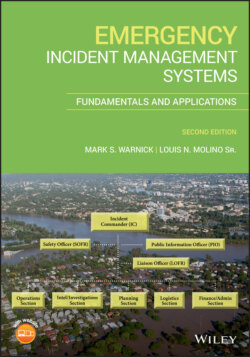Читать книгу Emergency Incident Management Systems - Mark Warnick S., Louis N. Molino Sr - Страница 49
2.3 The Importance of Knowledge and Experience
ОглавлениеIn managing an incident, knowledge and experience plays an important role in enjoying a successful outcome. The knowledge and experience needed is not only related to your field, but in the use of incident management. As you gain further knowledge and experience in incident management, it will become increasingly more natural to utilize crisis response management as a tool. If you only use it on occasion, then your knowledge and experience may be insufficient. Perhaps the best way to describe the effects of using incident management as a method to get from a starting point of an incident to the finishing point is to compare IMS to driving an automobile.
When you first start to drive an automobile, it is an uneasy and awkward experience. In most instances, you have to think through what needs to be done to ensure that you do not have an accident. If you take driving lessons only once a month, your skills at driving only slightly improve; however, if you drive daily, your skills tend to improve more, and it becomes less awkward, less frightening, and more like second nature. By driving every day for an extended amount of time, the process becomes second nature, and you do not even think about what you need to do; you just do it while watching for hazards.
This same analogy can be applied to incident management. When you first begin to use an IMS method, it can feel awkward and uneasy. If you use incident management only on occasion, you have to think through what needs to be done to avert a disaster, or to reduce instances of mistakes. If you use those concepts regularly, over time it becomes less awkward, less frightening, and more like second nature. If you use it daily for an extended amount of time, it becomes second nature. Every first responder should strive to make incident management‐second nature so that when a major incident does occur, they better prepared to manage the chaos that ensues.
Similarly, few people would take a single driving lesson, then decide to drive from Boston to Los Angeles. It also would not matter if the driver was a novice or an experienced driver, if they decided to drive from Boston to Los Angeles, it would normally take mitigation measures such as changing the oil, checking tires, and making sure the fluids in the engine compartment were topped off. By the same token, they would plan their route and the entire trip. This might include how much fuel it would take, how far they could drive in a day, what motels they will stay at, and of course, the route they should take.
Much like taking a long trip in a car, using an IMS method should somewhat mimic the process of mitigating problems in advance. We should not expect to be able to competently manage a major incident after only one lesson. We should practice, and practice even more, until we become highly proficient at IMS. Much like checking the oil and tires, we should include mitigation measures in our IMS method, and we should plan before an incident happens, not after we already in the thick of it.
Unfortunately, there are some agencies in public safety who have taken one or two classes, and they think they are competent and proficient enough to drive from Boston to Los Angeles. To put it bluntly, they think they can manage a catastrophic or Mass Casualty Incident (MCI) because they read about it and took a test. They fail to recognize that it takes planning, mitigation, and regular (and ongoing use) of an IMS method in order to be successful for the long trip they may have to face. IMS methods take practice, no matter what the system is named or the country where it originated.
